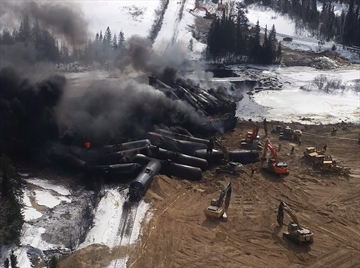Repost from Reuters
Alberta’s possible pivot to the left alarms Canadian oil sector
By Scott Haggett and Nia Williams, May 4, 2015 7:07am EDT(Reuters: CALGARY, Alberta) – Canada’s oil-rich province of Alberta is on the cusp of electing a left-wing government that can make life harder for the energy industry with its plans to raise taxes, end support for key pipeline projects and seek a bigger cut of oil revenues.
Polls suggest Tuesday’s election is set to end the Conservative’s 44-year reign in the province that boasts the world’s third-largest proven oil reserves and now faces recession because of the slide in crude prices.
Surveys have proven wrong in Canadian provincial elections before and voters may end up merely downgrading the Conservatives’ grip on power to a minority government.
Yet the meteoric rise of the New Democratic Party and the way it already challenges the status-quo of close ties between the industry and the ruling establishment has alarmed oil executives. The proposed review of royalties oil and gas companies pay the government for using natural resources and which could lead to higher levies, is a matter of particular concern.
“Now is not the time for a review of oil and natural gas royalties,” Tim McMillan, president of the Canadian Association of Petroleum Producers, the country’s top oil lobby, said in a statement.
A 2007 increase in the levy was rolled back when the global financial crisis struck and oil executives say today the time is equally bad to try it again.
Yet the left’s leader Rachel Notley, a former union activist and law school graduate, has shot up in popularity ratings in the past months advocating policies that have been anathema for many conservative administrations.
She says she would not lobby on behalf of TransCanada Corp’s controversial Keystone XL pipeline or support building of Enbridge Inc’s Northern Gateway pipeline to link the province’s oil sands with a Pacific port in British Columbia. Citing heavy resistance from aboriginal groups to the Enbridge line, Notley says Alberta should back those that are more realistic such as TransCanada’s Energy East pipeline to the Atlantic ocean.
PACKING UP?
Notley also advocates a 2 percentage point rise in Alberta’s corporate tax rate to 12 percent to shore up its budget that is expected to swing from a surplus to a C$5 billion deficit in 2015/2016 as energy-related royalty payments and tax revenues shrink.
Even with the proposed corporate tax hike Alberta’s overall taxes would remain the lowest nationally. Oil executives warn, however, that any new burdens at a time when the industry is in a downturn, shedding jobs and cutting spending, could prompt firms to move corporate head offices out of the province.
“Business is mobile,” said Adam Legge, president of the Chamber of Commerce in Calgary where most of Canada’s oil industry is based. “Capital, people and companies move.”
Ironically, the challenge the oil industry and the Conservatives face is in part a by-product of Alberta’s rapid growth fueled by the oil-sands boom.
The influx of immigrants from other parts of Canada and overseas has changed the once overwhelmingly white and rural province. Today Alberta is one of the youngest provinces and polls show younger and more diverse population is more likely to support left-wing causes such as environment and education and more critical of big business. The New Democratic Party still only got 10 percent of the votes in the 2012 vote, but an election of a Muslim politician as a mayor of Calgary in 2010 served as an early sign of the changing political landscape.
The Conservatives themselves and their gaffe-prone leader Premier Jim Prentice also share the blame for the reversal of fortunes with one poll showing them trailing the left by 21 percent to 44 percent.
Prentice angered voters when he told Albertans to “look in the mirror” to find reasons for the province’s fiscal woes and then passed a budget in March that raised individual taxes and fees for government services but spared corporations.
Scandals – Prentice’ s predecessor left last year because of a controversy over lavish spending – and blunders added to the party’s woes.
The NDP vaulted to the top of the polls after Notley’s strong performance in an April 23 televised debate, when Prentice, former investment banker, drew fire for suggesting his rival struggled with math.
Then there is voter fatigue with a party seen as too comfortable and scandal-prone after decades in power.
“It’s still the same gang, the same policy, same procedures, the same concept of entitlement,” said one executive at a large oil and gas producer who declined to be named because he is not authorized to talk to the media. “I know some extremely neo-conservative guys who have said enough is enough.”
(Additional reporting by Julie Gordon in Vancouver and Mike De Souza in Ottawa; Editing by Amran Abocar and Tomasz Janowski)


